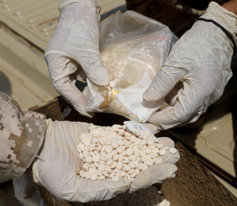The New Wave of Drugs in Europe: What You Need to Know

In the ever-changing world of narcotics, Europe stands at the crossroads of old challenges and new threats. As traditional drugs remain prevalent, a slew of new substances have emerged, capturing the attention of both authorities and the general public. At Narconon Europe, our mission is to empower through knowledge. By delving into the specifics of these emerging drugs, we aim to equip individuals and communities with the information they need to tackle these challenges head-on. In this article, we explore three drugs that have made headlines—Krokodil, Flakka, and Captagon. We’ll uncover their origins, effects, and the broader implications they hold for our European society. Knowledge is power, and together, we can pave the way for a safer tomorrow.
Krokodil: Europe’s Deadly Drug Menace

What is Krokodil?
Krokodil, scientifically known as desomorphine, is a potent opioid derived from codeine. It’s a sedative and painkiller that’s highly addictive. The drug gets its street name “krokodil” from the severe skin ulcerations and scale-like appearance it can cause, resembling that of a crocodile’s skin.
Why is Krokodil called the “Zombie Drug”?
Krokodil has earned the nickname “Zombie Drug” due to the devastating effects it can have on a user’s body. The drug can cause extreme skin ulcerations, infections, and gangrene, leading to a discolored, scale-like appearance.
How is Krokodil used?
Krokodil is typically injected directly into the veins. Its effects are rapid, occurring within 2 to 3 minutes of administration. The drug is known to be 10 to 15 times more potent than morphine and three times as toxic. The euphoric effects of krokodil are short-lived, often leading users to administer the drug repeatedly to avoid withdrawal symptoms.
The Dangers of Krokodil
The dangers of krokodil are extensive and alarming:
- Physical Damage: Users can experience severe vein damage, soft tissue infections, necrosis, and gangrene. There have been reports of users requiring amputations due to the damage caused by the drug.
- Mental Effects: Krokodil can lead to various altered mental states, including frightening delusions, violent aggression, extreme agitation, paranoid psychosis, and hallucinations.
- Other Health Risks: The drug can cause a range of health issues, including pneumonia, blood poisoning, bone infections, speech and motor skills impairment, memory loss, liver and kidney damage, and even death.
Is Krokodil in Europe?
There have been reports of krokodil use in various European countries, and its widespread presence remains a concern. European drug monitoring agencies have noted instances of krokodil use, especially in Eastern Europe. The European Monitoring Centre for Drugs and Drug Addiction (EMCDDA) has been vigilant in tracking the spread of this dangerous drug across the continent.
Krokodil Addiction and Treatment
Krokodil is highly addictive due to its potency and the short duration of its effects. Users can quickly become dependent, leading to binge patterns that can last for days. The risk of overdose is high, especially given the variations in potency and the homemade nature of the drug.
If someone is suspected of using krokodil, it’s crucial to seek medical treatment immediately. The physical and mental effects of the drug are severe, and early intervention can be life-saving.
Flakka: Europe’s Dance with the “Zombie Drug”

What is Flakka?
Flakka is a synthetic drug, similar in nature to amphetamines. It belongs to a group of drugs called cathinones, which are derived from the khat plant. The drug is often referred to as the “zombie drug” due to the bizarre and erratic behavior it can induce in users.
Is Flakka Legal in Europe?
No, Flakka is illegal in many European countries and is monitored by the European Monitoring Centre for Drugs and Drug Addiction (EMCDDA). It’s considered to have a high potential for abuse and is not recognized for any medical use within the European Union.
How is Flakka Consumed?
Flakka comes in pink or white crystal form. Users can eat, inject, snort, or even vaporize it using e-cigarettes. Vaporizing Flakka allows it to enter the bloodstream quickly, increasing the risk of overdose.
Flakka vs. Bath Salts: Are They the Same?
While Flakka is often compared to bath salts due to their chemical similarities, they are distinct drugs. Both belong to the synthetic cathinone class, but their effects and risks can vary. Like Flakka, bath salts can also lead to dangerous and unpredictable behavior.
The Effects of Flakka
Flakka affects the brain’s neurotransmitters, leading to a feeling of euphoria. However, the high can come with severe side effects, including:
- Hallucinations
- Paranoia
- Increased heart rate
- Seizures
Dangers of Flakka Use
The use of Flakka can lead to a condition known as “excited delirium,” characterized by violent behavior, self-injury, and extreme agitation. Overdose is a real concern, as are long-term effects like kidney damage or failure.
Signs of Flakka Abuse
If you’re worried your child might be using Flakka, look out for symptoms like:
- Aggressive behavior
- Delusions or paranoia
- Seizures or involuntary muscle jerks
- Prolonged dilation of the pupils
Captagon: The Drug Behind the Headlines

What is Captagon?
Captagon, originally manufactured in 1961, was developed as an alternative to amphetamines like methamphetamine, which were used to treat conditions such as narcolepsy, fatigue, and a behavioral disorder known as “minimal brain dysfunction.” The military also used amphetamines to help soldiers remain awake for extended periods and to boost their courage. Captagon was intended to serve as a milder version of these drugs.
Why Was Captagon Banned in Europe?
By the 1980s, European health authorities recognized the potential dangers of Captagon and many countries within the European Union classified it as a controlled substance, stating that it had no accepted medical use. As a result, its legal production and distribution were restricted or halted in several European nations during this decade. However, this did not signify the complete disappearance of Captagon from the European scene.
The Resurgence of Captagon
Despite its official ban, the illegal production of Captagon persisted and has seen a significant increase in recent years, particularly in Europe and the Middle East. It’s believed that Captagon has become a popular recreational drug among the affluent youth in the Middle East.
The Captagon available today, especially the version used by extremist groups like ISIS or ISI, is vastly different from the original 1980s version. Modern illicit production likely involves a mix of several potent stimulants, resulting in a highly addictive and destructive pill. This contemporary version of Captagon can cause significant and permanent alterations in the brain’s circuitry, particularly in areas governing impulse control and judgment. This means that regular users may lose their ability to reason or think rationally.
Captagon in the Media
The media has often highlighted Captagon’s association with conflict, dubbing it as “The Amphetamine Fueling Syria’s War” or “The Jihadists’ Drug.” The drug’s ability to enhance a soldier’s capabilities and its potential role in fueling violent behaviors has made it a topic of concern and intrigue.
Captagon has become a symbol of the dangers of unregulated drug production and use. Its association with extremist groups and its potential role in exacerbating conflicts in the Middle East underscores the broader societal implications of drug misuse.

Navigating the Drug Landscape: Knowledge is Power, Prevention is Key. Stay Informed with Narconon Europe.
The landscape of drug abuse in Europe is ever-evolving, with new threats emerging even as old ones persist. As we’ve explored in this article, drugs like Krokodil, Flakka, and Captagon pose significant challenges to our society, both in terms of individual health and broader societal implications. These drugs, with their potent effects and high potential for abuse, underscore the importance of staying informed and proactive in our approach to drug education and prevention.
At Narconon Europe, we believe that knowledge is the first line of defense against the scourge of drug abuse. Our commitment is unwavering: to educate individuals, families, and communities about the dangers of drugs and to provide them with the tools they need to make informed decisions. By shedding light on these emerging threats, we hope to prevent future tragedies and pave the way for a drug-free Europe.
As we continue our mission, we urge everyone to stay vigilant, stay informed, and most importantly, to reach out for help if they or someone they know is struggling with addiction. Together, with awareness and action, we can create a safer, healthier future for all of Europe.
Sources:


